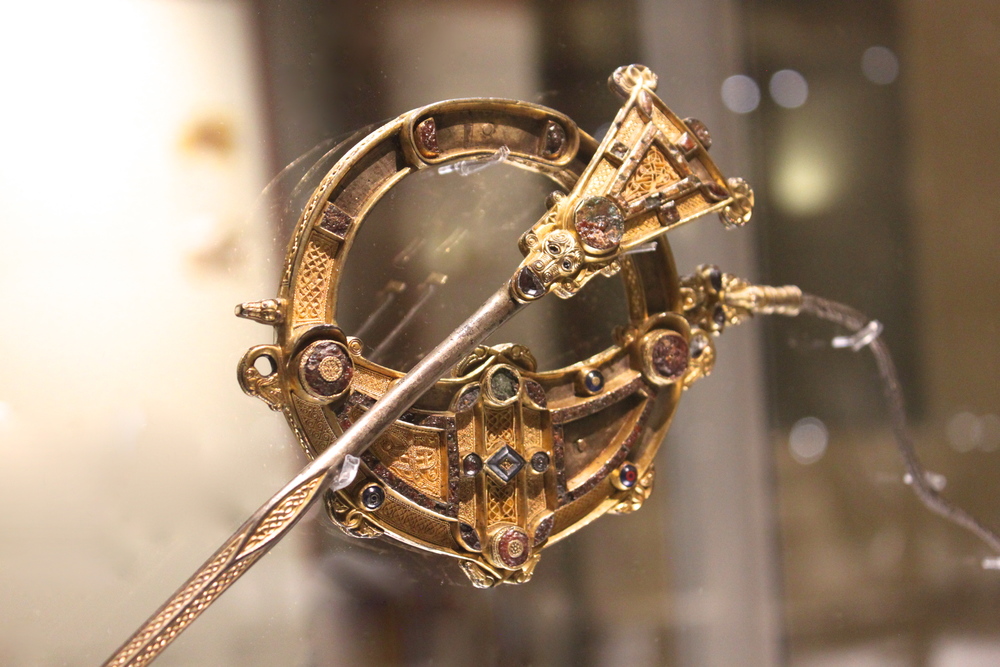This ring evokes the splendor of the Celts and their love of personal adornment. It is one of the most lavish surviving examples.
4th century B.C.Metropolitan Museum of Art
The images you'll see as you scroll down to the current text are all part of the story telling in my novel, Realms of Gold:Ritual to Romance.
Bianca Caldwell, pen name, Bianca Fiore, is a writer for an art magazine. In each of her monthly stories she describes an object used in ancient ritual.
The Tara Brooch
The Tara brooch. 8th century. This brooch was found not in Tara but near the seashore at Bettystown, Co. Meath, in 1850. Its provenance was attributed to Tara by a dealer in order to increase its value. It is made of cast and gilt silver and is elaborately decorated on both faces. The front is ornamented with a series of exceptionally fine gold filigree panels depicting animal and abstract motifs that are separated by studs of glass, enamel and amber. The back is flatter than the front, and the decoration is cast. The motifs consist of scrolls and triple spirals and recall La Tène decoration of the Iron Age.

See more at Reena Ahluwalia

A silver chain made of plaited wire is attached to the brooch by means of a swivel attachment. This feature is formed of animal heads framing two tiny cast glass human heads. Along with such treasures as the Ardagh Chalice and the Derrynaflan Paten, the Tara Brooch can be considered to represent the pinnacle of early medieval Irish metalworkers’ achievement. Each individual element of decoration is executed perfectly and the range of technique represented on such a small object is astounding. National Museum of Ireland.
See more at Reena Ahluwalia
Broighter Gold Collar Details
The Broighter Gold Collar. Concentric arches drawn by compass highlight raised decoration of S-shaped scrolls, trumpet shapes and lentoids. From the hoard of gold objects. Broighter, county Derry. 1st century BC.
See more at Reena Ahluwalia
The Coggalbeg Hoard: The Roscommon lunula
In March 1945 when a Roscommon farmer, Mr Hubert Lannon, was cutting turf on his bog in the west of Ireland. As he sliced through the dark peaty soil a flash of gold suddenly caught his eye. Bending down for a closer inspection he slowly uncovered a hoard of golden treasure. It consisted of a beautiful gold lunula and two gold discs, which had lain hidden in the depths of the bog for over 4,000 years. Hubert carefully gathered the precious items together and then brought them home for safe keeping.
The largest item in the newly discovered hoard was a beautiful gold lunula. This exquisitely made gold collar was shaped like a crescent moon. Flat and thin, it had been fashioned out of hammered sheet gold and was decorated in inscribed motifs. An item of great prestige it was probably originally worn around the neck. Lunulae, such as this one, appear to be a distinctively insular form of jewellery, with the vast majority of the 100 or so known examples coming from Ireland. They are a striking testament to the metal working skills of our Early Bronze Age ancestors.
The Roscommon lunula was also accompanied by two gold discs that were similarly made from sheet gold. These objects were decorated with a cross motif surrounded by a double circle. This was the first time lunula and discs had been found together. Indeed, the distinctive shapes of these objects led some experts to suggest that they may represent stylised moon and sun symbols. Why they were buried together in a bog remains uncertain, but it is possible that they represented an offering to some prehistoric deity. This deposition of precious objects in watery places is characteristic of much of Irish prehistory.
Subscribe to:
Posts (Atom)





